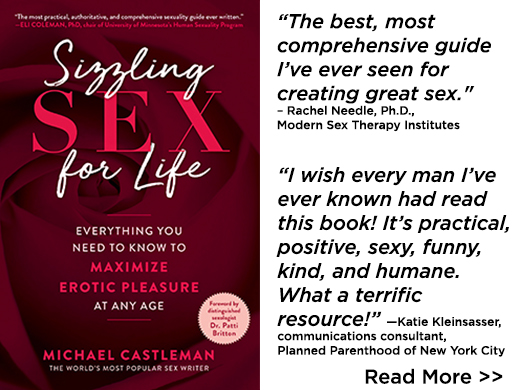
This is the weird, improbable story of vaginal orgasms. More than a century ago, a famous physician postulated their existence. Sixty years later, the first scientific sex researchers declared them nonsense. Finally, over the past 40 years, sex researchers have documented the controversial vaginal orgasm—but have also shown it to be completely different from what the concept’s originator had assumed. The upshot is that vaginal orgasms are real—but they’re much less about the vagina than the clitoris.
Freud Postulate Vaginal Orgasms
Sigmund Freud (1856-1939) began his career in late-19th century Vienna, Austria, as a neurologist. At the turn of the 20th century, he founded psychoanalysis, which catapulted him to worldwide fame as one of the most influential thinkers of the twentieth century. Some of his ideas revolutionized psychology, notably, his concepts of the subconscious and unconscious minds.
Freud was well aware of the visible clitoris, the little nub of erotically sensitive tissue outside the vagina an inch or two above it nestled beneath the top junction of the vaginal lips. He understood that caressing it produced orgasms. He felt fine about adolescent girls self-sexing to clitoral orgasms. But he believed that when girls became women, married, and experienced intercourse with their husbands, they abandoned “immature” clitoral orgasms and, if mentally healthy, somehow graduated to the “mature” vaginal kind. According to Freud, if women did not have orgasms during intercourse, they were neurotic sexual failures, “frigid.” Meanwhile, only a small proportion of women reported orgasms during intercourse. Freud concluded that most women were neurotic and frigid.
Masters and Johnson Debunk Vaginal Orgasms
Years after Freud’s death, at Washington University in St. Louis during the 1960s, William Masters, M.D., and Virginia Johnson conducted the first scientific investigations of human sexuality. They closely observed volunteers during solo and partner sex, and wired their bodies, including their genitals, to gather reams of data that tracked the physiological changes involved in lovemaking.
Masters and Johnson determined that the vagina is a major organ of sexual pleasure—for men. When aroused men insert erections into receptive, well-lubricated vaginas, they enjoy tremendous pleasure, and around 95 percent of the time, have orgasms. Masters and Johnson also showed that the vagina contains surprisingly few touch-sensitive nerve receptors. They declared the clitoris women’s main pleasure organ.
Embryology proved their point. The clitoris develops from the same embryonic cells as the head of the penis, and has a similar configuration of nerve receptors that respond to pleasurable touch.
Masters and Johnson called Freud mistaken. They insisted there was no such thing as vaginal orgasms. All orgasms originated in the clitoris. The few women who reported orgasms during intercourse did not have the vaginal variety. Rather, during intercourse, some men’s pubic bones provided sufficient clitoral stimulation to allow these women to climax.
Late-20th Century Feminists Reject Freud
Masters and Johnson released their findings in Human Sexual Response, published in 1966. The late 1960s also marked an upsurge in feminist thinking about women’s health and sexuality.
Feminist sexuality activists had major issues with Freud:
• They ridiculed his lack of scientific rigor. He’d psychoanalyzed a modest number of well-to-do patients, mostly Viennese women, and from this skewed sample, extrapolated what he called universal truths.
• They dismised Freud’s notion of “penis envy.” Freud said girls look between their legs, see nothing, and unconsciously wish they had what boys have. Feminists heaped scorn on this. Boys look at their chests and don’t see the breasts women have, yet Freud never said men suffer breast envy.
• Finally, feminists embraced Masters and Johnson’s explanation of women’s orgasms—they’re all clitoral. They railed against Freud’s belief that women who could not have vaginal orgasms were frigid. They dismissed him as completely ignorant of women’s sexuality.
Since the 1980s, critiques of Freudian psychoanalysis by feminists and others have greatly reduced Freud’s influence, tarnished his legacy, and helped turn many clinical psychologists from psychoanalysis to other approaches. Today the American Psychological Association has 120,000 members, the American Psychoanalytic Association just 2.5 percent of that, 3,000.
The G-Spot Returns Attention to the Vagina
During the 1940s, soon after Freud’s death and a generation before the dawn of modern feminism, two gynecologists, Ernst Grafenberg and Robert Dickinson, discovered “a zone of erogenous feeling” in the front wall of the vagina, an area then called the “urethral sponge.” In a 1950 report, they claimed this zone contained erectile tissue that swelled when massaged, possibly enhancing orgasm.
No one paid any attention until the 1980s, when sex researchers Alice Kahn Ladas, Ed.D., Beverley Whipple, Ph.D. and John Perry, Ph.D, unearthed the Grafenberg/Dickinson research and renamed the area the Grafenberg spot or G-spot. Their 1982 book, The G-Spot And Other Recent Discoveries About Human Sexuality, became a best-seller, and triggered a stampede of interest in the newly popularized spot. Millions of women and couples tried to find it, but only some succeeded, which made the G-spot controversial.
Some researchers dismissed the G-spot as fantasy, but a dozen subsequent studies and testimony from thousands of women attested to its reality and presence in all women. Many women say G-spot massage enhances lovemaking and orgasm. Replying to skeptics, Ladas, Whipple, and Perry said the G-spot is not on the front vaginal wall, but deep inside it, most easily found and stimulated when women are highly aroused, when swelling of the area makes it more palpable and sensitive.
The Discovery of the Clitoral Crura
When the G-spot book appeared, anatomists were reasonably familiar with the front wall of the vagina. They knew it contained two structures, one on each side, they called the “vestibular bulbs.” What did they do? No one knew.
In 1998, studies by an Australian urologist, Helen O’Connell, M.D., showed that the vestibular bulbs were actually attached to the visible clitoris and were part of it. O’Connell argued that the clitoris included much more than the little noticeable bump. It was actually shaped like a wishbone. Its apex was the visible clitoris, but it also had two legs (crura) that extended out and down, around the pubic bone and into the front wall of the vagina. In other words, the G-spot was actually the legs of the clitoris. That’s why many ( but by no means all) women experience pleasure from pressing on the G-spot.
The expansion of the clitoris to include the G-spot remains controversial and researchers will, no doubt, continue to debate it for years. But it makes sense to me. Some researchers now say the expanded clitoris should be called this mouthful, the “clitoro-urethro-vaginal complex.” Others say the G-spot should be renamed the C-spot, in recognition that it’s part of the clitoris.
The Vaginal Orgasm Reconsidered
In 2013, French researchers used ultrasound imaging to document what happened when women volunteers self-pleasured the visible clitoris by hand or stimulated their clitoral crua with dildos. They found that stimulation of the visible clitoris does not excite the C-spot, but that pressure on the front vaginal wall brings its own particular pleasure. Their conclusion: The vaginal front wall’s potential for unique pleasure supported the idea of vaginal orgasms.
So, can women have vaginal orgasms? Apparently so—thanks to the clitoris.
PS: A tip of the hat to Rebecca Chalker for her term “clitoral truth,” the title of her excellent book.





